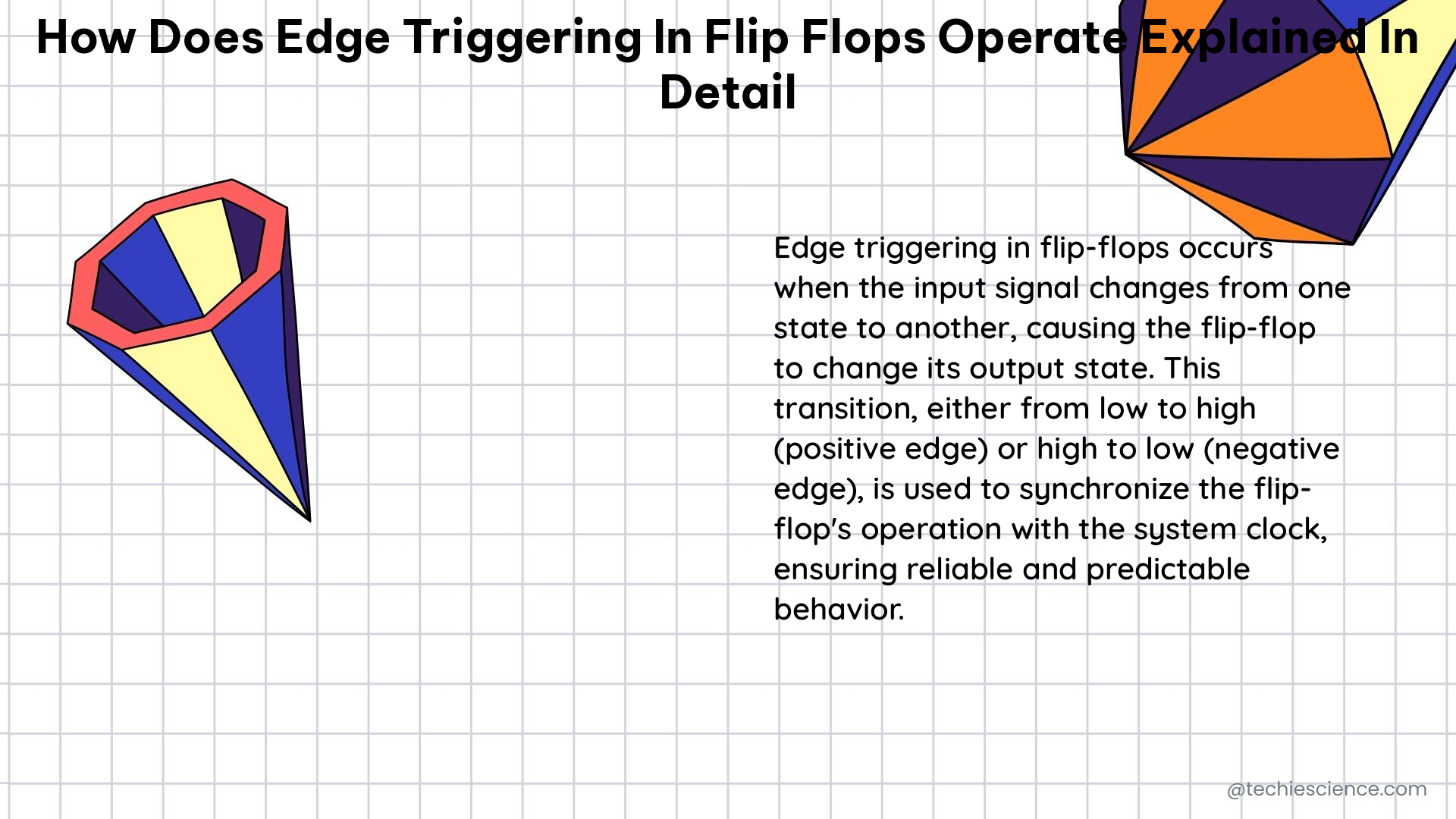Edge triggering in flip flops is a fundamental concept in digital electronics, and understanding its operation is crucial for designing reliable and efficient digital circuits. This comprehensive guide will delve into the intricacies of edge triggering, providing you with a deep understanding of how it works and the key parameters that govern its behavior.
Understanding the Basics of Edge Triggering
Edge triggering in flip flops refers to the mechanism that allows the state of a flip flop to change only during a small period of time when the clock pulse is transitioning from 0 to 1, known as a positive edge trigger. This is in contrast to level-triggered flip flops, which change state as long as the clock signal is high.
The SN74AUC1G79 single positive-edge-triggered D-type flip-flop, for example, is designed to operate within a voltage range of 0.8-2.7V, with an optimal range of 1.65-1.95V. When the data at the data (D) input meets the setup time requirement, the data is transferred to the Q output on the positive-going edge of the clock pulse. The setup time is the minimum amount of time that the data input must be held stable before the clock edge, in order to ensure reliable transfer to the output.
Key Parameters in Edge-Triggered Flip Flops

- Propagation Delay Time:
- The propagation delay time is the amount of time it takes for a change at the input to be reflected at the output.
-
For the SN74AUC1G79, the propagation delay time for the inverting and non-inverting outputs is typically 8ns and 1.3ns, respectively.
-
Pulse Duration:
- The pulse duration is the minimum amount of time that the clock pulse must be high in order to reliably trigger the flip flop.
-
For the SN74AUC1G79, the minimum pulse duration is typically 3.3ns.
-
Setup Time:
- The setup time is the minimum amount of time that the data input must be held stable before the clock edge, in order to ensure reliable transfer to the output.
-
Ensuring the data input meets the setup time requirement is crucial for the proper operation of the edge-triggered flip flop.
-
Hold Time:
- The hold time is the minimum amount of time that the data input must be held stable after the clock edge, in order to ensure reliable transfer to the output.
-
The hold time, along with the setup time, defines the timing requirements for the data input in an edge-triggered flip flop.
-
Clock-to-Output Delay:
- The clock-to-output delay is the time it takes for the output to change after the clock edge.
-
This parameter is important in determining the maximum clock frequency at which the flip flop can operate.
-
Metastability:
- Metastability is a phenomenon that can occur in edge-triggered flip flops when the data input changes too close to the clock edge.
- This can result in an unpredictable output state, which can lead to system failures.
- Proper design and timing considerations are necessary to minimize the risk of metastability.
Advantages of Edge Triggering
The use of edge-triggered flip flops can offer several advantages over level-triggered flip flops:
- Elimination of Race Conditions:
- Race conditions can occur in level-triggered flip flops when multiple inputs are changing at the same time.
-
By only allowing the state to change on the positive edge of the clock pulse, edge-triggered flip flops ensure that all inputs are stable before the state is updated, eliminating the risk of race conditions.
-
Improved Timing Margins:
- Edge-triggered flip flops have tighter timing requirements, which can lead to improved timing margins and more reliable operation.
-
The setup and hold time requirements, along with the clock-to-output delay, define the timing constraints that must be met for the flip flop to function correctly.
-
Reduced Power Consumption:
- Edge-triggered flip flops can consume less power than level-triggered flip flops, as they only need to be active during the clock edge transition.
- This can be particularly beneficial in low-power applications, where power consumption is a critical design consideration.
Design Considerations for Edge-Triggered Flip Flops
When designing with edge-triggered flip flops, there are several important considerations to keep in mind:
- Timing Analysis:
- Performing a thorough timing analysis is crucial to ensure that the setup and hold time requirements are met for all data inputs.
-
This analysis should take into account the propagation delays, clock-to-output delays, and any other timing-related parameters.
-
Clock Distribution:
- Proper clock distribution is essential in edge-triggered flip flop designs to ensure that the clock signal reaches all flip flops simultaneously.
-
Clock skew, which is the difference in arrival time of the clock signal at different flip flops, can lead to timing violations and system failures.
-
Metastability Mitigation:
-
Strategies to mitigate the risk of metastability, such as using synchronizers or metastability-hardened flip flops, should be implemented to ensure reliable operation.
-
Power Optimization:
- Techniques like clock gating and power-aware design can be employed to optimize the power consumption of edge-triggered flip flop-based circuits.
By understanding the intricacies of edge triggering in flip flops and applying the appropriate design considerations, you can create robust and efficient digital circuits that leverage the advantages of this fundamental concept.
References:
- Texas Instruments. SN74AUC1G79 Single Positive-Edge-Triggered D-type Flip-Flop. https://www.ti.com/lit/ds/symlink/sn74auc1g79.pdf?ts=1711514969147
- Reddit. Clarification on Edge-Triggered Flip-Flops vs latches. https://www.reddit.com/r/ECE/comments/174drfr/clarification_on_edgetriggered_flipflops_vs/
- All About Circuits. Edge-triggered Latches: Flip-Flops | Multivibrators. https://www.allaboutcircuits.com/textbook/digital/chpt-10/edge-triggered-latches-flip-flops/
- Engineering LibreTexts. 9.4: Edge Triggered Flip-Flop. https://eng.libretexts.org/Bookshelves/Electrical_Engineering/Electronics/Book:Digital_Circuit_Projects–An_Overview_of_Digital_Circuits_Through_Implementing_Integrated_Circuits%28Kahn%29/09:Memory_Basics-_Flip-Flops_and_Latches/9.04:_Edge_Triggered_Flip-Flop

The lambdageeks.com Core SME Team is a group of experienced subject matter experts from diverse scientific and technical fields including Physics, Chemistry, Technology,Electronics & Electrical Engineering, Automotive, Mechanical Engineering. Our team collaborates to create high-quality, well-researched articles on a wide range of science and technology topics for the lambdageeks.com website.
All Our Senior SME are having more than 7 Years of experience in the respective fields . They are either Working Industry Professionals or assocaited With different Universities. Refer Our Authors Page to get to know About our Core SMEs.